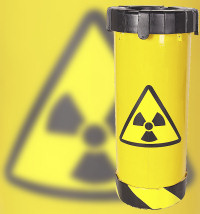Study shows plutonium in warheads last longer than expected
The plutonium in nuclear warheads seems to be much sturdier than previously thought, with a reliable life span of as much as 100 years.

Scientists who studied all of the warheads in the government's nuclear arsenal reported that plutonium pits the core of the weapon can be counted on to work as expected for twice as long as once believed.
The classified report's conclusions were released Wednesday by the National Nuclear Security Administration, the semiautonomous agency within the Energy Department that oversees the nuclear weapons program.
"These studies show that the degradation of plutonium in our nuclear weapons will not affect warhead reliability for decades," said Linton Brooks, head of the NNSA.
But he added the plutonium in the form of softball-size "pits" that serve as a trigger for nuclear detonation is not the only thing that might go wrong as a warhead ages. Therefore, plans to design sturdier, long-lasting warheads will proceed as planned.
"Although plutonium aging contributes, other factors control the overall life expectancy of nuclear weapons systems," said Brooks.
The agency also plans to continue to seek money from Congress for construction of a new factory to manufacture plutonium pits, although opponents of such a facility argue the new study suggests it is not needed.
The new findings "show, on a practical basis, that we don't need expensive, provocative new nuclear weapons designs and industrial-scale bomb production. These proposals make the U.S. appear hypocritical when preaching to other nations that they can't have weapons of mass destruction," said Jay Coghlan of Nuclear Watch of New Mexico, a group that monitors activities at the Los Alamos National Laboratory in New Mexico.
Susan Gordon, director of the Alliance for Nuclear Accountability, said the study makes a new pit-making plant unnecessary. "The U.S. has a huge surplus of plutonium pits and now DOE's own independent expert scientists confirm that they last 100 years," she said.
The alliance represents a network of citizen groups near federal nuclear weapons facilities.
The research was conducted by nuclear engineers at the Los Alamos and Lawrence Livermore weapons laboratories and reviewed by an outside panel of nuclear physicists and weapons experts known as the JASON panel.
The government has long assumed that plutonium would deteriorate to where it no longer could be relied upon in 45 years to 60 years. The new study put the expected minimum lifetime for plutonium pits at 85 years to 100 years, depending on the warhead.
"What this (finding) does do is it informs us that pit age isn't the primary thing that concerns us," said Tom D'Agostino, NNSA deputy administrator for defense programs.
But he said plutonium aging is only one variable that can affect overall system reliability and that the report does not change the need to manufacture more plutonium pits or design sturdier warheads, reports AP.
The country currently has no pit manufacturing plant, using pits taken out of dismantled warheads. D'Agostino said the agency still wants to have a new pit production facility by 2022 to assure future supplies.
Other aging factors that could impact on weapon reliability, he said, include deterioration of high-explosives and other organic components in the weapons and corrosion of weapons parts.
Subscribe to Pravda.Ru Telegram channel, Facebook, RSS!


